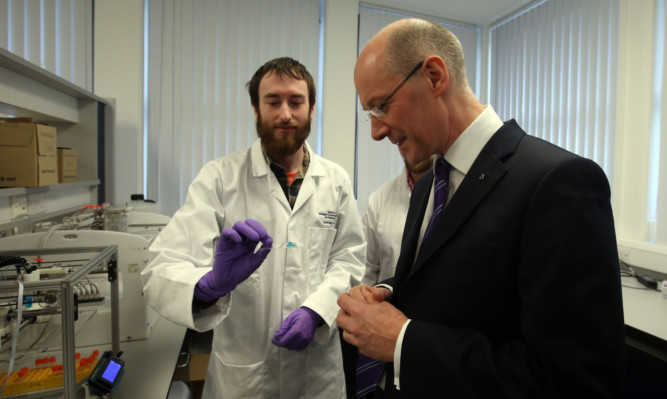A more powerful Scottish Parliament would provide Scotland with more tools to boost the country’s economic performance and public finances, the Deputy First Minister has said.
John Swinney said that, according to Scottish Government analysis, if Scotland was able to retain and reinvest all the proceeds of improved economic performance through holding greater economic powers, it could maximise the impact of its economic policies on GDP, employment and tax revenue.
He was speaking ahead of a visit to the life sciences laboratory at Heriot-Watt University in Edinburgh to mark the publication of Scotland’s annual accounts – the Government Expenditure and Revenue Scotland (Gers) figures covering the financial year 2013-14.
Scottish Labour said that SNP plans for full fiscal autonomy in the UK would result in either “massive” cuts to services or an estimated £2,400 tax hike per household.
The party’s finance spokeswoman Jackie Baillie said the policy, under which Scotland would collect all taxes and be responsible for all spending while making payment to Westminster for common services such as defence, would result in “austerity max”.
However the Scottish Government said even small changes in Scotland’s economic performance can have a big impact on tax revenue and employment
Mr Swinney said: “Last week we published Scotland’s economic strategy and set out how we plan to achieve a more productive, cohesive and fairer country. Our approach to investment in jobs and services is in stark contrast to the path adopted by Westminster.”
He said the Scottish Government’s proposals would see UK public spending increase by 0.5% a year in real terms, providing an additional £180 billion of investment in public services compared to the austerity plans set out by the UK Government.
He added: “That is money which can and will support our NHS, our education system and boost the economy.
“Relatively small changes in productivity, investment and exports together with the ability to retain and reinvest additional tax revenues generated by increased economic activity can have a huge impact on our economy if we are able to receive the benefit of it.
“The limited powers proposed by the Smith Commission, mean that a large part of this additional tax revenue would be retained by the UK Government instead of being directly reinvested back into the Scottish economy to deliver greater growth.
“It does not make sense to continue down the same path of Westminster economic management and UK cuts to public spending, when instead we could improve levels of productivity, investment and exports to boost our economy whilst protecting our public services and tackling the inequalities in our society.”
The Scottish Government said that, over a 10 year period and with additional fiscal control beyond that set out in the Smith Commission agreement, increasing Scotland’s total factor productivity by an additional 0.1% a year could boost GDP by 1.8%, employment by 29,000 and tax revenue by £700 million.
Scottish Labour said they expect the Gers figures for 2014-15 to show a deficit of more than £6 billion.
Ms Baillie said: “From a Labour perspective we believe in major new powers for the Parliament coming through the Smith Commission coupled with the security of Barnett, because that gives us stable spending on things like schools, the NHS and retains pensions as a UK-wide system.
“The SNP have repeatedly said they want full fiscal autonomy whilst remaining in the UK, and that of course is where Scotland raises all its taxes for all its spending.
“What they won’t admit is that that will result in massive cuts to services, particularly when you consider what we’ve said about the deficit likely to be £6 billion in 2014-15.”
